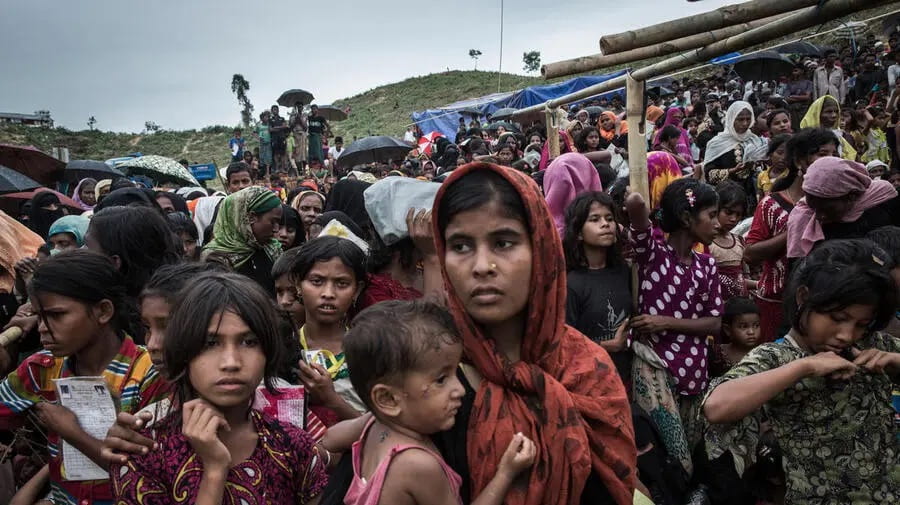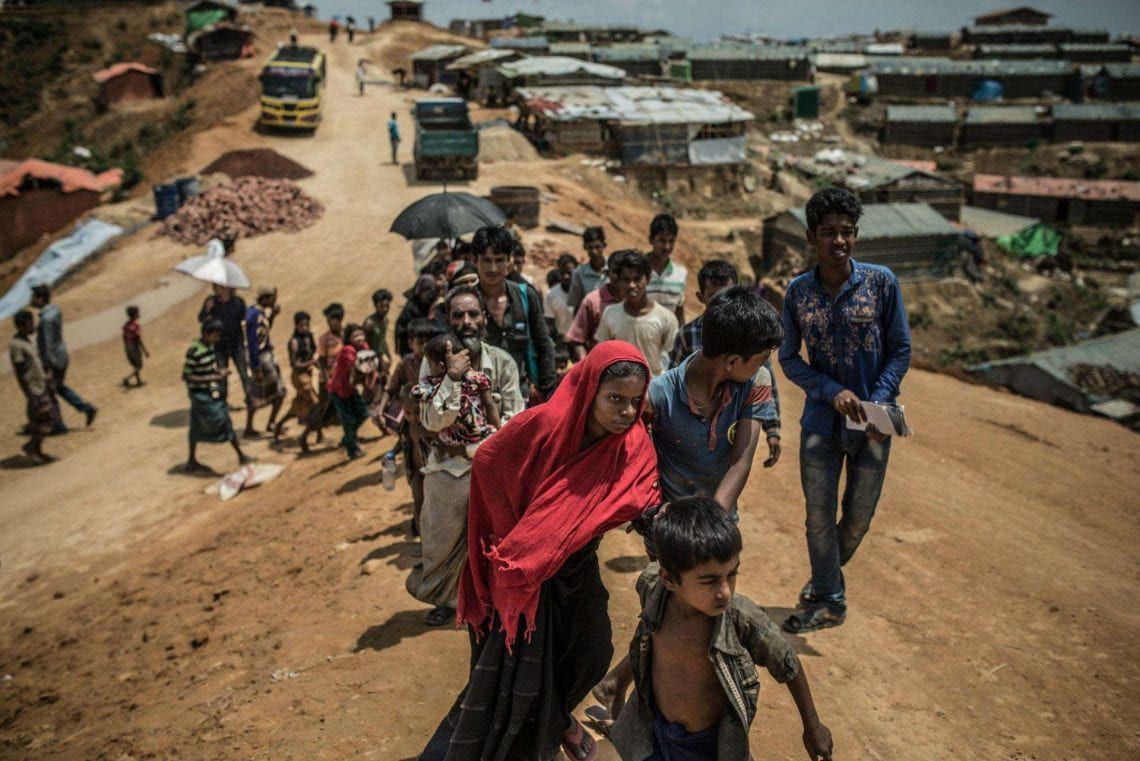To listen to the story click here.
Ahsan Bari
As many as ONE MILLION forcibly displaced Rohingyas are currently residing in several crammed refugee camps scattered across Bangladesh’s coastal district of Cox’s Bazar. To put that into perspective, the number of people accounts for over one-sixth of Denmark’s total population.
The word “Rohingya” refers to a Muslim ethnic group from the Rakhine State of Myanmar bordering Bangladesh. It is believed to be derived from the word – “Rohang” – which was the name of an ancient kingdom in the region, combined with the suffix “-ya,” which means “people of” in the Rohingya language.
Although the exact origin of the word is debated, Rohingyas have historically lived in the Rakhine for generations but have been subjected to decades of persecution, marginalization, and gross humanitarian violations (houses burned, women raped, children killed) by the Myanmar Military Junta.

Rohingya Crisis At A Glance
- Rakhine State unrest led hundreds of Rohingya to flee in August 2017
- Bangladesh has sheltered almost 960,000 Rohingya
- Most Rohingya refugees in Bangladesh dwell at Cox’s Bazar, the world’s largest refugee camp
- The Muslim Rohingya have been stateless since 1982 in Buddhist Myanmar
- Without citizenship and basic rights, Rohingya are subject to exploitation and abuse
This has led to the world’s biggest humanitarian and refugee crisis that many, especially in the EU/Denmark, do not know a lot about.
How it all started – Key figures and factors
Ashin Wirathu
Starting from the early 2000s, led by Buddhist monk Ashin Wirathu, a group started amplifying their anti-Rohingya rhetoric across Myanmar. In 2003, Wirathu was jailed for inciting anti-Muslim violence. He then was released in 2012 as part of a prisoner amnesty. Myanmar’s highest Buddhist authority banned him from preaching for a year for his tirades in 2017.
The monk is the leader of the infamous 969 Movement – as per which Myanmar should remain a Buddhist country and calls for restrictions and boycotts on its Muslim minority.

The far-right monk then again was put behind bars in 2020 after turning himself in to the authorities over charges of attempting to bring “hatred or contempt” and of “exciting disaffection” towards the then-government of Aung San Suu Kyi. Her government was overthrown by the Myanmar army in a 2021 coup and Wanthu’s release came soon after as he and his followers aligned with the interest of the military.
Use of Facebook
Facebook played a very pivotal role in inciting violence against the Rohingyas in Myanmar. They came down heavily in portraying them as a significant threat to the Buddhist way of life in Myanmar. The posts shared and curated by Ashin often contained hate speech and false narratives about the Muslim minority, contributing to a climate of fear and hostility.

Wirathu, who was referred to as the “Burmese Bin Laden” by The Time magazine, was instrumental in spreading conspiracy theories and incitements to violence, leveraging the platform’s reach to influence public opinion against the Rohingya.
Myanmar Army’s role
The Myanmar military capitalized on the widespread propaganda fueled by figures like Wirathu. Fake FB accounts and pages, in the guise of news outlets/lifestyle pages, kept on building on what the controversial Buddist and his follwers started by falsely accusing Rohingyas of stockpiling weapons and planning jihadist attacks on Burmese soil. Following a series of attacks by Rohingya insurgents, which were themselves a response to escalating repression against the ethnic minority, the military in Myanmar initiated a brutal campaign against the Rohingyas back in 2017.

These operations involved systematic acts of violence which included – the burning of villages and massacres, driving over 700,000 Rohingya to seek refuge in Bangladesh during that period. The military’s actions, purportedly in response to the insurgent attacks, were characterized by atrocities that have been widely condemned as ethnic cleansing or even genocide by different international human rights organisations.
Going back home still a dream
“We want to go back home. We want a safe and honourable repatriation. We hope that the logical and valid demands of the Rohingyas will catch the eye of the international community,” said Zubair, a Rohingya leader living in one of the refugee camps in Cox’s Bazar, Bangladesh, to a leading Bengali daily last year, marking the 6th anniversary of the Rohingya crisis.

Rohingya Crisis At A Glance
- Violence forced about 742,000 to migrate to Bangladesh in August 2017
- Villages were burnt and human rights violations were widespread
- Since the 1990s, about 1 million Rohingya have fled Myanmar
- 52% of Rohingya refugees in Bangladesh are youngsters, 51% women and girls
- Bangladesh has evacuated almost 30,000 refugees to Bhasan Char island since 2021
Echoing the same, Muhammad Ibrahim of the Muchni Rohingya camp in Teknaf said, “Our main demand to the world is to return to our motherland, Myanmar, with honour and dignity. The Bangladesh government has set an example by giving refuge to us. We are grateful to them.”
Mohammed Mizanur Rahman, serving as the Refugee Relief and Repatriation Commissioner (RRRC) since September 2022, in an interview with Bangladeshi English daily The Business Standard (TBS), said, “All [the Rohingyas] want to go back if they [Myanmar] say they will take them back to their place of origin and make the process of citizenship easy. They know camp is not a place to live with any dignity.”
However, the repatriation efforts, the longing of the Rohingyas to return home, remain an elusive dream, as the international community has yet to successfully convince the Myanmar authorities to take back their people while ensuring their safety and security.

Rohingya Crisis At A Glance
- Thailand (92,000) and India (21,000) have Rohingya refugees, while Indonesia, Nepal, and others have smaller numbers
- Myanmar has around 1.8 million internally displaced people (IDPs), 1.5 million since February 2021
- Refugee camps suffer floods, landslides, and infections during monsoon season
- Cyclone Mocha in May 2023 affected 2.3 million Bangladeshis, including 930,000 Rohingya refugees
To put things into perspective, a million Rohingya refugees will take over 200 years to return to Myanmar, even if 5,000 are repatriated every year. Also, from a geo-political perspective, China and India, regional entities with strategic interests in Myanmar, are influential. China has mediated Bangladesh-Myanmar talks since the start and, not surprisingly enough, has also opposed and blocked UN Rohingya resolutions and comments, as it stands as a great ally to Myanmar despite having healthy ties with Bangladesh.
Meanwhile, the United Nations (UN) supports the safe and voluntary repatriation of the Rohingyas, and the organisation has been very vocal in this regard, but it has refrained from directly participating in recent pilot schemes and reiterated that conditions in Myanmar are not yet suitable for the return of the Rohingyas.
Several international human rights bodies — in light of Human Rights Watch (HRW) and Amnesty International (AI) — have criticized Rohingya conditions in Myanmar and repatriation methods. A return of the Rohingyas without citizenship, safety, and dignity violates international human rights, they have said on many occasions, but all these efforts have yet to bear any fruit, and the long wait for the ethnic minority to return to their motherland continues without a respite coming anytime soon.



